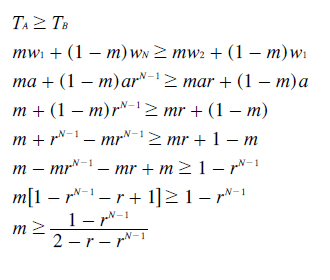Mathematical Proofs: Majority and Related Criteria
Proof EM2: Majority Threshold as a function of Common Ratio and Number of Candidates
Scenario: Candidate A has at least one half of all the first preferences; the proportion of all such ballots cast being m (where 1/2 ≤ m ≤ 1). Candidate B has all the remaining first preferences; this proportion therefore being 1 - m. Candidate B also has the second preference of every voter that ranked A as their first preference; the proportion hence being m. This scenario provides B with the best opportunity to beat A despite A having more first preferences than B.
With a limited field of candidates and where voters do not truncate preferences but fully complete their ranked ballots, then the required majority of first preferences (m) varies according to the number of candidates (N) standing as well as the common ratio (r) used. The worst case for A (and best for B) is when A is ranked last by those voters giving their first preferences to B.
Using standard notation and formats, the profile for this election scenario is given below.
- m : A,B,****.
- 1-m: B,****,A.
The standard GV weightings are used here to determine the tallies for candidates A and B. The tallies for the other candidates are irrelevant as none of them can possibly beat B. For candidate A to avoid being beaten by B, the tally for A (TA) must be greater than or equal to the tally for B (TB). By evaluating these tallies, the required majority of first preferences (m) as a function of the common ratio (r) and the number of candidates (N) can be derived; as shown below.

The majority threshold is therefore m = (1 - rN-1)/(2 - r - rN-1) and values of m exceeding this threshold guarantee victory to candidate A.
Return to main text > Evaluations: Majority Criteria 2
Refer to > Mathematical Proofs: Table of Contents
